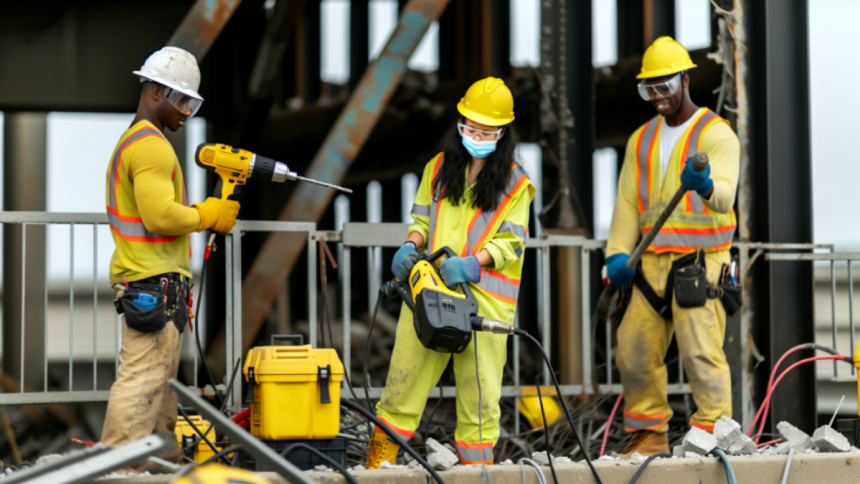The first sound you hear is the low rumble of machinery starting up. The crew gathers in a circle, their hard hats catching the morning sun. It might look like the calm before the storm, but what’s about to happen is carefully choreographed—planned down to the last bolt and beam.
Demolition is often seen as controlled chaos. Walls come down, concrete crumbles, and structures vanish in hours or days. But behind the scenes, there’s a complex safety framework ensuring that every step is deliberate and secure.
The Invisible Planning Phase
Before a single machine moves, the groundwork for safety begins. A site assessment is the first step. Teams examine the building’s condition, identifying potential hazards like unstable walls, hidden electrical lines, or hazardous materials.
From there, a safety plan is created—not just for the demolition crew, but for anyone who might be near the site. This can include setting boundaries, scheduling work at certain times, and coordinating with local authorities.
The Gear That Protects the Crew
Hard hats and steel-toe boots are just the start. Modern demolition services often require respirators, hearing protection, reinforced gloves, and high-visibility vests. Each piece of gear serves a purpose, protecting workers from falling debris, loud noise, and airborne particles.
The crew’s readiness isn’t a formality—it’s a shield against the risks that come with dismantling large structures.
Equipment Inspections and Readiness
Demolition relies on heavy machinery—excavators, loaders, and specialized attachments designed to cut, crush, and lift. Every piece of equipment must be inspected before use, ensuring it’s in safe working order.
Even small mechanical failures can create dangerous situations, so crews treat maintenance as part of their safety protocol, not an afterthought.
Communication as a Lifeline
On a busy site, clear communication is vital. Hand signals, radios, and designated spotters keep everyone in sync. When a wall is coming down or machinery is swinging into place, there’s no room for guesswork.
Professional demolition services train their teams to anticipate each other’s movements, reducing the chance of unexpected accidents.
Managing the Debris
As structures come apart, debris is constantly being created. Managing it isn’t just about cleanup—it’s about keeping pathways clear, preventing trip hazards, and avoiding unstable piles.
Some teams establish zones for separating materials as they work. Concrete might be piled in one area for recycling, while scrap metal is stacked in another. This organization supports both safety and sustainability.
Protecting the Surrounding Area
Demolition doesn’t happen in isolation. Nearby buildings, roads, and even pedestrians can be affected by the work. Safety barriers, dust suppression systems, and signage help minimize disruption and prevent harm to the public.
These measures are especially important in urban environments, where space is tight and activity is constant.
The Role of Environmental Safety
Part of safe demolition is ensuring that the work doesn’t create new hazards for the environment. Proper disposal of materials like asbestos, lead paint, or chemical storage tanks is essential. Mishandling them can cause long-term harm far beyond the site itself.
Many modern demolition services integrate environmental protocols into their overall safety plans, ensuring compliance with regulations while protecting the community.
Training and Ongoing Education
Safety in demolition is a moving target—technology changes, regulations shift, and new risks emerge. Crews stay sharp through regular training sessions, drills, and certifications.
For companies like Dump Brothers Demolition & Junk Removal, this commitment ensures that every project benefits from the latest safety knowledge and best practices.
Why Safety Equals Speed
It might seem like all these protocols would slow things down, but the opposite is true. A safe site is an efficient site. When workers know their roles, equipment is reliable, and hazards are controlled, the job flows without costly interruptions.
Instead of reacting to emergencies, crews can focus on the task at hand—bringing the structure down on schedule.
The Quiet Confidence of Prepared Work
From the outside, demolition can seem loud, fast, and messy. But to the trained eye, it’s a highly controlled operation where safety is the foundation of every move.
Whether it’s a small building or a massive structure, demolition services that prioritize safety deliver more than cleared land—they offer the confidence that the job has been done right from start to finish.
Dump Brothers brings this same mindset to every site, ensuring that what might look like chaos is actually the product of discipline, planning, and skill.
Lynn Martelli is an editor at Readability. She received her MFA in Creative Writing from Antioch University and has worked as an editor for over 10 years. Lynn has edited a wide variety of books, including fiction, non-fiction, memoirs, and more. In her free time, Lynn enjoys reading, writing, and spending time with her family and friends.















